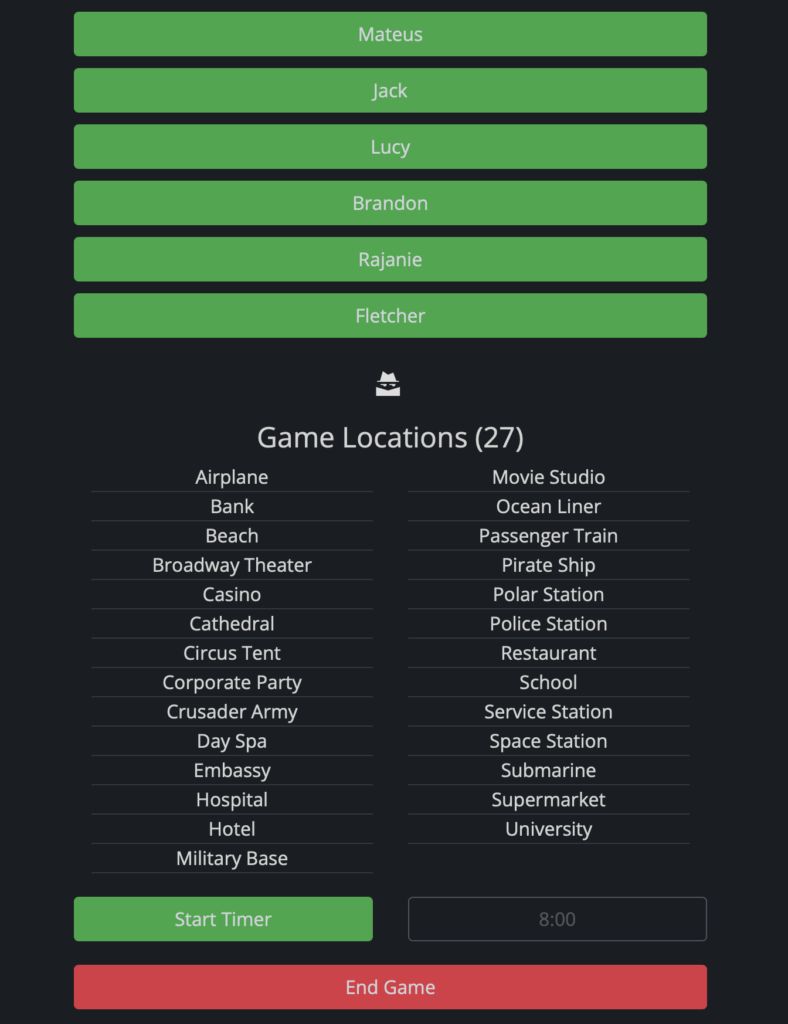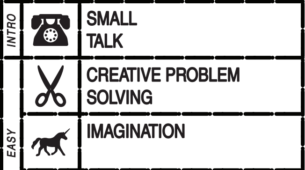In this post, I will present a critical report on Spyfall, a game developed primarily with the goal of breaking the ice at parties or social gatherings. It typically targets an audience of teenagers or young adults. The game was designed by Ukrainian game designer Alexandr Ushan and initially published by Hobby World in 20141. It has become a popular choice for casual play and is available in both physical card format and online platforms such as https://spyfall.adrianocola.com/, accommodating 3 to 8 players.
My experience with Spyfall took place at a party with a group of friends. This context gave me a particular perspective on the game’s mechanics, shaped by my personal knowledge of the other players—and vice versa. Interestingly, this familiarity became a double-edged sword, providing both strategic insight and exposing my own weaknesses as other players could easily interpret my behavior. In this report, I will focus on both positive and negative aspects of Spyfall within the context of a group of friends who already know each other. Some of the main positives include high interactivity, simplicity in gameplay, and accessibility. On the downside, the game can suffer from unbalanced speaking time and disproportionate difficulty for players assigned the spy role.
Let us first consider the strengths of the game. One major advantage is its simplicity. It was incredibly easy for us to start playing—minimal setup was required. All we needed was a cellphone with internet access. After accessing the website, each person created a nickname, and within two minutes, more than six people were playing. Two of my friends who had never played before understood the rules quickly, within the first round. Figure 1 illustrates the digital game interface, showing how easily a group can start a match with just a few clicks.
Another strong positive of Spyfall among friends is its high level of interactivity. There are no traditional “turns” in the game, so everyone was actively engaged throughout. We were constantly asking and answering questions, often resulting in funny, unique, and sometimes wonderfully weird dialogues. This made the game highly engaging and enjoyable. However, I recognize that in a different setting—such as among strangers—this level of interaction might be reduced. Shyness and fear of being inappropriate could discourage people from participating as freely.

In contrast to these positives, there are a few downsides to the game’s mechanics and dynamics. Although the core appeal of Spyfall is its mystery and deduction element, this can be monopolized by outgoing and talkative players. Their dominance may unintentionally overshadow shyer players, negatively affecting their experience. This creates an imbalance that favors those who take initiative.
Additionally, the spy role is considerably more difficult than the non-spy roles. During our game night, the spy won in fewer than 10% of the rounds—that is, they were rarely able to guess the location without being discovered. This challenge is amplified in a group of friends, where players are more familiarized to each other’s personalities and can easily spot when someone is acting unusually or struggling to answer naturally. In contrast, in a group of strangers, tricky or vague answers are more common and less suspicious, making it easier for the spy to blend in. One way to help balance this could be increasing the number of non-spy players, which would dilute suspicion and improve the spy’s odds of success.
In conclusion, despite its minor flaws, Spyfall is a well-designed game and an excellent choice both for a group of friends looking for a fun and interactive game night, and for situations where ice-breaking is needed—such as conference workshops where participants are meeting for the first time.
Footnotes
- BoardGameGeek. Spyfall: Credits. https://boardgamegeek.com/boardgame/166384/spyfall/credits



